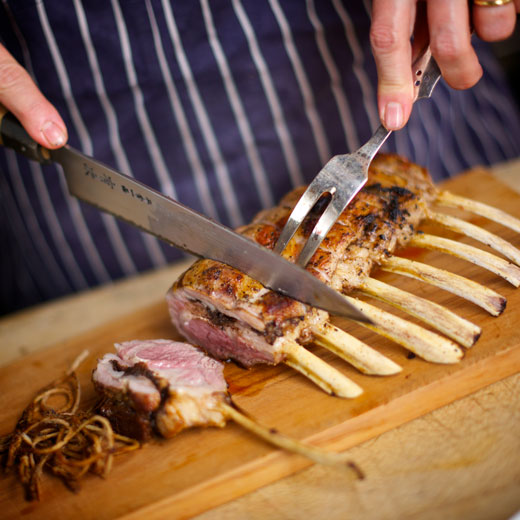Lamb Racks with Tapenade
So often when you buy lamb racks they are frenched with most of the fat and meat in the cap removed. Frenching is when the fat cap is cut away to expose the meat and bones of the rack. The meat in between the bones is then cut away so that the bones show. This is a fancy way to serve rack of lamb.
The cap that is removed is full of fat and meat that is delicious but often discarded. The frugal cook will remove the meat found in the cap and cook it for a snack or roast it and add it to stock to make it richer.
I like to keep some of the fat cap and meat intact and use it to form a pocket to stuff with tapenade. The melting fat of the cap keeps the rack juicy and prevents overcooking. Serves 6 to 8.
Ingredients
- 2 x 8 to 9 rib bone lamb racks - fat cap intact, not Frenched
- 2 tablespoons tapenade
- Butcher’s string
- 3 fresh rosemary sprigs, about 4 inches long
Directions
1. Prepare the rack. Place the rack bone side down on a cutting board. If the shoulder blade is at one end carefully cut it out with a sharp knife to form a pocket.
2. Cut through the fat at the point where the eye of the rack meats the bone, draw your knife across the bone taking care not to cut into the meaty eye of the rack. Use the opposite end of the rack where the meat meets the rib bone to guide the line you are cutting across the bones.
3. After the first cut is made slide you knife blade down the rib bones to the tips using the bones as a guide and keeping your blade flat against the bone. Remove the fat to reveal the rib bones.
4. Cut the meat from between the bones. Use the bone to guide your knife to cut each side of the rib meat and then make a cut where the rib meat meets the rack eye and remove. Rib meat can be cooked up for a treat or added to stock.
5. Place the rack rib side down. The fat cap will now cover only the meaty eye of the rack. If the shoulder blade is at one end of the rack, cut it out carefully and retain the meat around it in the cap.
6. The top layer of fat should be carefully cut away so that the fat forms a thin layer on top of the meat. The pocket that the cartilage removal made should be used to help separate the thin layer of fat from the meaty center of the rack to form a flap.
7. Pull the flap of fat and meat back to reveal the meat of the rack eye. Be careful not to pull the flap too hard or it will detach at the top spine edge of the rack.
8. Spread the tapenade evenly on the meat the length of the rack and pat the fat flap back into place.
9. Tie a piece of string around the rack between each bone to keep the flap on and form a round with the rack eye.
10. Trim the ends of the string and then season all sides of the rack well with salt and pepper.
11. Preheat oven to 400 degrees F.
12. Place a large pan over medium/medium high heat. Add racks to the pan and brown on the fat side for 5 to 7 minutes until fat is golden and rendered. Turn over and brown on rib side for 3 to 4 minutes.
13. Turn rack over so fat side is up and place the rosemary sprigs on top. Place the pan in the preheated oven. Roast for 15 to 17 minutes for medium rare.
14. Remove the rack from the pan and rest on a plate for 15 minutes before slicing. Remove string and slice between the bones into chops.
15. Serve with the sides of your choice.


